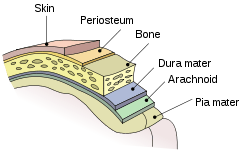Have you ever broken or fractured a bone in your body? If so, you have your periosteum to thank for patching you back up. This little talked about layer is responsible for the growth, development, maintenance and repair of our bones. The periosteum is a thin fibrous sheath that envelops bones. It contains blood vessels and nerves that provide nourishment and sensation to the bone. With out it our bones would not receive nutrients, would be ill protected and with out a means to repair itself, leaving us brittle, delicate and frail.
Check out this brief video for a peek, and a few more specifics about the periosteum:
https://www.youtube.com/watch?v=8A0rRIpjutY
So, what really happens when you do break or fracture a bone?
Initally, the bleeding sources from the blood vessels in the bone and periosteum. This forms a hematoma beneath the surface of the periosteum. In the days following the fracture or break the periosteal cells replicate. The periosteum controls the healing process and provides cells that develop reparative cells, chondroblasts and osteoblasts that are essential in the healing process. The chondroblasts, which form nearer the break, later form into cartilage. The osteoblasts, which form away from the break, develop into woven bone. With time the cartilage and the woven bone join to form fracture calluses and are eventually replaced by llamellar bone, and then trebecular bone.
As you can imagine, the periosteum is thicker in children aiding in the pliability and flexibility of their skeleton as it is composed of more cartilage. With time and growth the skeleton hardens to bone, decreasing the amount of periosteum coverage as we age. This is why adults, especially the elderly are more prone to fractures and breaks. The periosteum is a “multifunctional tissue that permits our bone to adapt throughout life to changing mechanical, hormonal, and pathological circumstances.” Medicographia. 2012; 34: 221 – 227.

